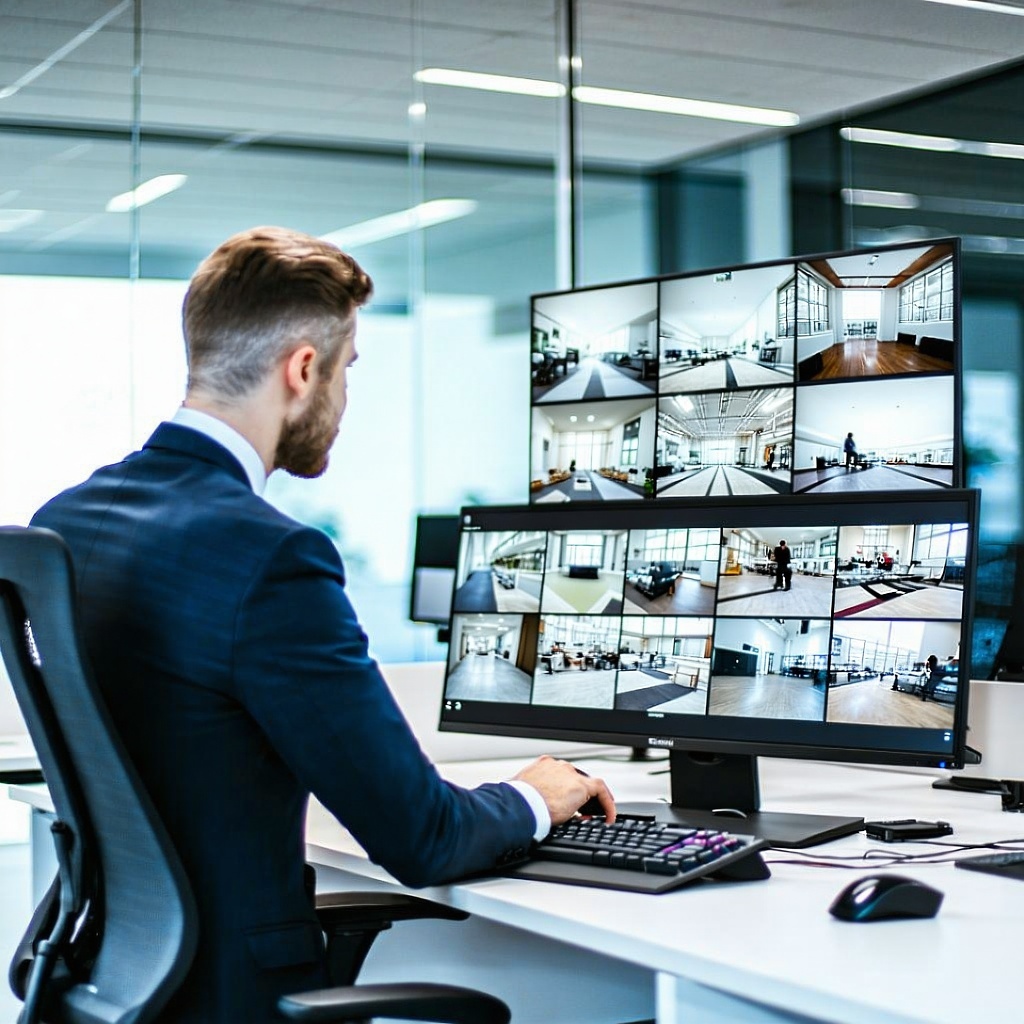1 min read
Video Surveillance Best Practices: Implementing a Security Camera System for Business
Did you know that a recent study found integrating advanced video analytics into surveillance systems can enhance incident detection accuracy by up...
6 min read
 Tony Ridzyowski
:
Oct 15, 2025 5:00:00 AM
Tony Ridzyowski
:
Oct 15, 2025 5:00:00 AM
When optimizing operations and protecting assets within a manufacturing plant, the standard consumer-grade security camera system simply will not suffice. Plant managers and EHS directors face unique challenges: high levels of dust and vibration, low-light operations, and the critical need to enforce safety protocols across vast, multi-zone facilities.
A robust, enterprise-level video surveillance system designed for the rigors of the industrial environment is not just about loss prevention; it is a foundational tool for ensuring safety, compliance, and efficiency in a manufacturing setting. This guide explores the specialized solutions and features required to build a reliable manufacturing video surveillance platform that meets these demands.
Manufacturing facilities expose technology to conditions that quickly degrade typical commercial security cameras. The optimal surveillance system must be purpose-built to withstand the environmental stressors common on the factory floor, ensuring reliable performance and longevity. Investing in industrial surveillance cameras built for durability is a critical first step in establishing effective manufacturing security camera coverage.
Industrial cameras must feature specialized construction to protect sensitive electronics from harsh elements.
Look for camera systems with durable, industrial-grade materials and weather-resistant casings designed to protect against dust, heat, and humidity. Protection standards like the IP (Ingress Protection) rating are essential; for instance, an IP66 rating confirms the camera is "dust tight" and protected from high-pressure water jets, making it suitable for hazardous environments. For volatile industries, such as chemical processing or steel production, explosion-proof housing provides the maximum level of safety and reliability, being both waterproof and dust-tight.
The continuous operation of heavy machinery and production lines generates constant vibration and significant temperature fluctuations.
Standard camera systems are not designed to handle these stresses, leading to premature failure or degraded video quality. The best quality commercial-grade cameras are specifically engineered to withstand sustained vibrations and extreme temperatures, maintaining crystal-clear video footage under the most challenging circumstances. This focus on ruggedization ensures consistent performance and minimizes the operational downtime associated with camera maintenance or replacement in difficult-to-reach areas of a manufacturing plant. For more general guidance on hardware, see this resource on choosing the right enterprise video surveillance system.
Many manufacturing facilities operate around the clock, making reliable low-light and nighttime performance a necessity for complete security and oversight.
Infrared (IR) night vision is a common feature that ensures clear monochrome footage in the dark, with high-quality cameras offering IR distances up to 260 feet, providing comprehensive coverage for large production areas and storage yards. For scenarios where color detail is important, commercial-grade cameras use powerful video sensors and advanced optics to provide clear color footage even in low-light settings. This superior low-light performance is essential for a security team to accurately assess and respond to incidents during off-hours, when crime is most likely to occur.
Beyond physical durability, the effectiveness of a video surveillance system in a manufacturing context depends heavily on its intelligent features. Modern systems use advanced video analytics and specialized camera types to transform passive monitoring into an active, proactive security and compliance tool.
AI-powered video analytics are a game-changer for monitoring large manufacturing facilities without requiring constant human oversight.
Cameras can be configured to detect critical "line-crossing events," which immediately trigger an alarm if a worker or unauthorized individual enters a pre-defined unsafe or restricted zone. Advanced analytics go further, providing human body detection, auto-tracking, and motion detection to quickly identify security and safety violations in real time, like an employee not wearing required PPE. Integrating these video intelligence features allows the security team to respond proactively to potential hazards, rather than relying solely on after-the-fact recorded video review.
A single type of camera cannot efficiently cover the varied indoor and outdoor environments found within a manufacturing facility.
The combination of these camera types ensures that all critical zones have the appropriate field of view and protective features, maximizing the return on investment for the security camera system.
Manufacturing operations often span vast, multi-building campuses or remote sites where traditional network cabling may be impractical or costly.
For challenging locations that suffer from unstable or non-existent WiFi, cameras with integrated 4G/5G SIM card connectivity provide a vital solution, ensuring uninterrupted video monitoring regardless of network infrastructure. Similarly, outdoor perimeter security or sites with an inconsistent power supply benefit significantly from solar-powered cameras, which eliminate the need for extensive trenching and electrical work. These alternative connectivity options are essential for providing a complete surveillance solution across the entire enterprise.
While high-quality hardware is the foundation, the software that orchestrates all cameras and analytics—the Video Management System (VMS)—is what ultimately delivers actionable intelligence. A VMS is the command center for any effective modern video surveillance system.
A VMS integrates all components—cameras, network video recorder (NVR), and analytics—into a unified platform for centralized oversight.
This centralized management is crucial for large manufacturing facilities or organizations with multiple locations, enabling security teams to view live feeds, manage alerts, and review recorded video from a single dashboard. Features like multi-location management allow a single operator to oversee dozens of sites simultaneously, ensuring a consistent application of safety and security protocols across the entire organization. Modern VMS platforms are often camera-agnostic, meaning they can integrate with existing IP security cameras, maximizing the utility of prior investments.
Leading Video Management Systems now incorporate powerful AI to enhance security and operational efficiency significantly.
These platforms provide features that go well beyond basic motion detection, using AI video analytics for sophisticated functions like license plate recognition, object tracking, and advanced anomaly detection. For managers who are often remote or off-site, cloud-based video access is essential, offering the ability to view camera feeds and receive alerts instantly via a smartphone, tablet, or PC. This blend of remote accessibility and intelligent processing elevates the VMS to a core piece of the facility's management systems.
A successful video surveillance deployment is less about buying the most expensive equipment and more about crafting a solution tailored to the site’s specific operational risks. The best practice is to partner with an experienced security solutions provider who understands the unique compliance and operational needs of the manufacturing industry.
The video surveillance system should not operate in isolation; it must be a core component of a broader physical security strategy.
Integrating the video feeds with an access control system can provide immediate visual verification for every door, gate, or restricted zone access event, dramatically reducing false alarms and improving response times. This convergence of technologies allows a facility to leverage video footage not only for forensic review but also for real-time decision-making regarding safety, security, and facility access. A well-designed system makes it easier for the business owner to monitor compliance across all operations.
In a large-scale automotive parts assembly facility, the primary challenge was not external threats, but internal compliance with strict safety procedures, particularly the mandatory use of safety harnesses at specific workstations. By deploying high-resolution dome cameras linked to a VMS with AI video analytics, the facility was able to configure "no-harness" alerts. The system automatically flagged instances where a worker entered the zone but was not detected wearing the required PPE, sending a real-time alert to the floor supervisor. Within three months, documented safety compliance improved by over 90%, demonstrating how advanced video intelligence can drive operational excellence and reduce accident liability simultaneously. This proactive approach shows the value of the surveillance solution extending beyond mere security.
Selecting the best video surveillance system for manufacturing is a strategic decision that impacts safety, compliance, and long-term business operations. It requires expertise in industrial-grade hardware, sophisticated video management software, and the ability to integrate with existing physical security infrastructure. As of September 2025, the competitive landscape offers powerful, scalable, and intelligent options for any facility. To begin designing a robust system that meets your specific facility requirements, including dust, vibration, and safety monitoring, you need a customized assessment.
For a deeper dive into available security solutions for physical security products and high-definition video surveillance, please review our physical security product offerings.
Upgrade your operational oversight with a purpose-built industrial surveillance system. Request a tailored quote from Turn-key Technologies today.
Turn-key Technologies has been designing and deploying advanced surveillance systems in industrial settings for over three decades. Their deep understanding of the manufacturing environment—dust, vibration, low visibility—means every system they build is engineered for real-world conditions, not lab specs.
Manufacturers across sectors rely on TTI to meet OSHA compliance, reduce safety violations, and maintain 24/7 visibility across sprawling facilities. From rugged camera hardware to intelligent video management platforms, TTI delivers complete, field-proven solutions that scale. Explore real-world case studies to see how manufacturers improve security and safety with TTI systems.
.png)
1 min read
Did you know that a recent study found integrating advanced video analytics into surveillance systems can enhance incident detection accuracy by up...
%20(1).png)
The physical security market is experiencing significant growth, with projections indicating it will expand at a CAGR of 8.03% from 2023 to 2028,...

1 min read
Enterprise security leaders face a critical challenge: selecting a video surveillance system that addresses current threats while adapting to future...